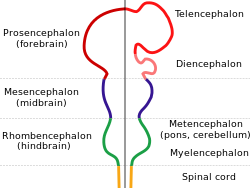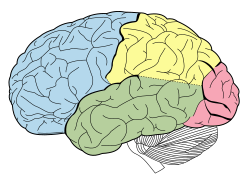| Cerebrum | |
|---|---|
The lobes of the cerebral cortex include the frontal (blue), temporal (green), occipital (red), and parietal (yellow) lobes. The cerebellum (unlabeled) is not part of the telencephalon. | |
 Diagram depicting the main subdivisions of the embryonic vertebrate brain. | |
| Details | |
| Pronunciation | /ˈsɛrɪbrəm/, /sɪˈriːbrəm/ |
| Artery | Anterior cerebral, middle cerebral, posterior cerebral |
| Vein | Cerebral veins |
| Identifiers | |
| Latin | cerebrum |
| MeSH | D054022 |
| NeuroLex ID | birnlex_1042 |
| TA98 | A14.1.03.008 A14.1.09.001 |
| TA2 | 5416 |
| TH | H3.11.03.6.00001 |
| TE | E5.14.1.0.2.0.12 |
| FMA | 62000 |
| Anatomical terms of neuroanatomy | |
The cerebrum (pl.: cerebra), telencephalon or endbrain[1] is the largest part of the brain, containing the cerebral cortex (of the two cerebral hemispheres) as well as several subcortical structures, including the hippocampus, basal ganglia, and olfactory bulb. In the human brain, the cerebrum is the uppermost region of the central nervous system. The cerebrum develops prenatally from the forebrain (prosencephalon). In mammals, the dorsal telencephalon, or pallium, develops into the cerebral cortex, and the ventral telencephalon, or subpallium, becomes the basal ganglia. The cerebrum is also divided into approximately symmetric left and right cerebral hemispheres.
With the assistance of the cerebellum, the cerebrum controls all voluntary actions in the human body.
- ^ "BrainInfo". braininfo.rprc.washington.edu.
